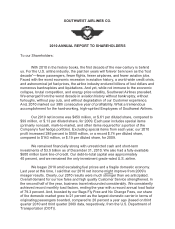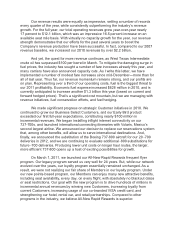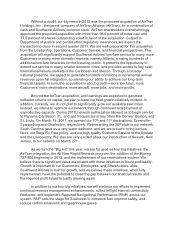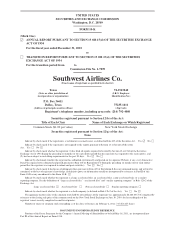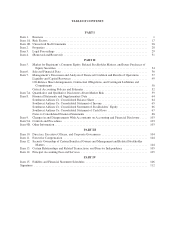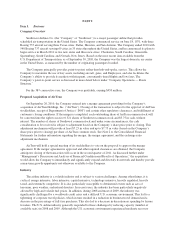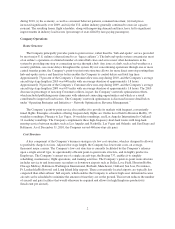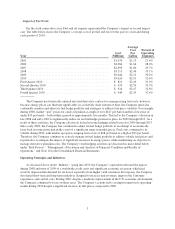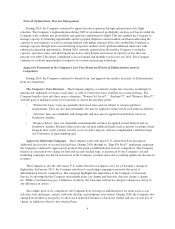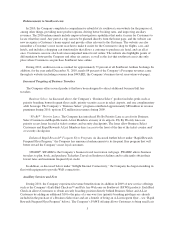Southwest Airlines 2010 Annual Report Download - page 7
Download and view the complete annual report
Please find page 7 of the 2010 Southwest Airlines annual report below. You can navigate through the pages in the report by either clicking on the pages listed below, or by using the keyword search tool below to find specific information within the annual report.PART I
Item 1. Business
Company Overview
Southwest Airlines Co. (the “Company” or “Southwest”) is a major passenger airline that provides
scheduled air transportation in the United States. The Company commenced service on June 18, 1971, with three
Boeing 737 aircraft serving three Texas cities: Dallas, Houston, and San Antonio. The Company ended 2010 with
548 Boeing 737 aircraft serving 69 cities in 35 states throughout the United States, and has announced its plans to
begin service in March 2011 to two new states and three new cities: Charleston, South Carolina; Greenville-
Spartanburg, South Carolina; and Newark, New Jersey. Based on the most recent data available from the
U.S. Department of Transportation, as of September 30, 2010, the Company was the largest domestic air carrier
in the United States, as measured by the number of originating passengers boarded.
The Company principally provides point-to-point, rather than hub-and-spoke, service. This allows the
Company to maximize the use of key assets, including aircraft, gates, and Employees, and also facilitates the
Company’s ability to provide its markets with frequent, conveniently timed flights and low fares. The
Company’s point-to-point service is discussed in more detail below under “Company Operations — Route
Structure.”
For the 38th consecutive year, the Company was profitable, earning $459 million.
Proposed Acquisition of AirTran
On September 26, 2010, the Company entered into a merger agreement providing for the Company’s
acquisition of AirTran Holdings, Inc. (“AirTran”). Closing of the transaction is subject to the approval of AirTran
stockholders, receipt of Department of Justice (“DOJ”) and certain other regulatory clearances, and fulfillment of
customary closing conditions. If the merger is completed, each outstanding share of AirTran common stock will
be converted into the right to receive 0.321 shares of Southwest common stock and $3.75 in cash, without
interest. The number of shares of Southwest common stock and, under some circumstances, the cash
consideration to be received is subject to adjustment based on the Company’s share price prior to closing. This
adjustment mechanism will provide at least $7.25 in value and up to $7.75 in value (based on the Company’s
share price prior to closing) per share of AirTran common stock. See Note 2 to the Consolidated Financial
Statements for further information regarding the merger, the merger agreement, and the exchange ratio
adjustment mechanism.
AirTran will hold a special meeting of its stockholders to vote on the proposal to approve the merger
agreement. If the merger agreement is approved and other required clearances are obtained, the Company
anticipates closing of the transaction will occur in the second quarter of 2011. As discussed further under
“Management’s Discussion and Analysis of Financial Condition and Results of Operations,” the acquisition
would allow the Company to immediately and significantly expand and diversify its network and thereby provide
a near-term growth opportunity not otherwise available to the Company.
Industry
The airline industry is a volatile industry and is subject to various challenges. Among other things, it is
cyclical, energy intensive, labor intensive, capital intensive, technology intensive, heavily regulated, heavily
taxed, and extremely competitive. It is also particularly susceptible to detrimental events such as acts of
terrorism, poor weather, and natural disasters. In recent years, the industry has been particularly negatively
affected by high and volatile fuel prices. In addition, during 2008 and most of 2009, the industry was
significantly challenged by a worldwide credit crisis and a difficult U.S. economic environment. This led to a
tightening of corporate travel policies, which in turn resulted in a reduction in business travel demand and a
decrease in the percentage of full-fare purchases. This also led to a decrease in discretionary spending by leisure
travelers. The U.S. airline industry generally responded to these challenges by reducing capacity (number of
available seats) in 2008 and 2009. Although the U.S. economic environment experienced moderate recovery

